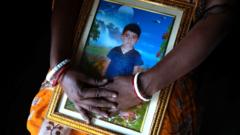In the Sundarbans, where three children drown daily, a collective of mothers is stepping up by creating community creches to care for young children, driven by their own tragic experiences. With increasing drowning rates during monsoon and a lack of healthcare, these mothers advocate for safety measures while also promoting education about CPR and swimming to mitigate this pressing issue.**
Mothers Rise Against Drowning Tragedies in India's Sundarbans**

Mothers Rise Against Drowning Tragedies in India's Sundarbans**
In response to alarming drowning incidents, mothers in India's Sundarbans are establishing makeshift creches, embodying resilience and proactive measures to safeguard children from watery dangers.**
In the Sundarbans, a vast delta in India’s West Bengal state, a heart-wrenching tragedy unfolds daily as three children drown, with families living in the shadow of this repeated sorrow. Mangala Pradhan, who lost her one-year-old son Ajit 16 years ago, embodies the painful experiences many in the region endure. After a typical morning's distractions, little Ajit slipped away and drowned in a pond near their home. His story, like many others, is a stark reminder of the dangers lurking in this region, where every household has a pond used for daily chores and bathing.
Today, Mangala is part of a group of 16 mothers dedicated to changing this bleak narrative. They travel to makeshift creches established by Child In Need Institute (CINI), where they care for approximately 40 children daily. “These mothers are the saviours of children who are not their own,” states Sujoy Roy from CINI, emphasizing the urgent need for child supervision amid a longstanding issue of drownings in the area.
A significant 2020 survey revealed nearly three children between one and nine drown every day in Sundarbans, with spikes in incidents during monsoon months and often when caregivers are busy with household tasks. The shocking statistics show that most drownings occur within mere meters of home, with a horrifying lack of access to medical care following such incidents.
Local folklore exacerbates the issue, where superstition often takes the place of preventive measures. Families resort to chants and old customs when someone is rescued from drowning. Mangala, now a proactive guardian for the community's children, shares her heart-wrenching journey to rally other parents. “I don't want any other mother to endure what I did,” she asserts, advocating for urgent safety measures in the community.
Sujata Das, another mother who lost her young daughter Ambika to drowning, reflects this collective pain that has now transformed into action. Residents are now motivated to fence their ponds with bamboo and nets to prevent such tragedies, while discussions around teaching CPR have gained momentum among community members.
Despite progress, the challenges associated with changing local beliefs and cultural practices present significant hurdles. Swim classes and educational campaigns mimic successful initiatives in neighboring Bangladesh, where a similar approach has led to an 88% reduction in child drowning rates through the establishment of creches.
As communities in the Sundarbans confront this pressing issue, stories of profound loss and newfound determination echo throughout the region. Kakoli Das, who also experienced the devastating drowning of her son Ishan last summer, joins the chorus of mothers pleading for change: “Please, I beg every mother: fence your ponds, learn to revive children and teach them how to swim. This is about saving lives.”
Hope shines through these makeshift creches, providing a safer environment for children. Young ones engage in playful learning while singing songs that remind them to stay near their parents and to learn how to swim.
The Sundarbans, known for its natural beauty and dangers alike, presents a complicated scenario where mothers like Mangala, Sujata, and Kakoli stand on the frontline, actively fighting against a disheartening fate and striving to secure a safer future for their children.




















